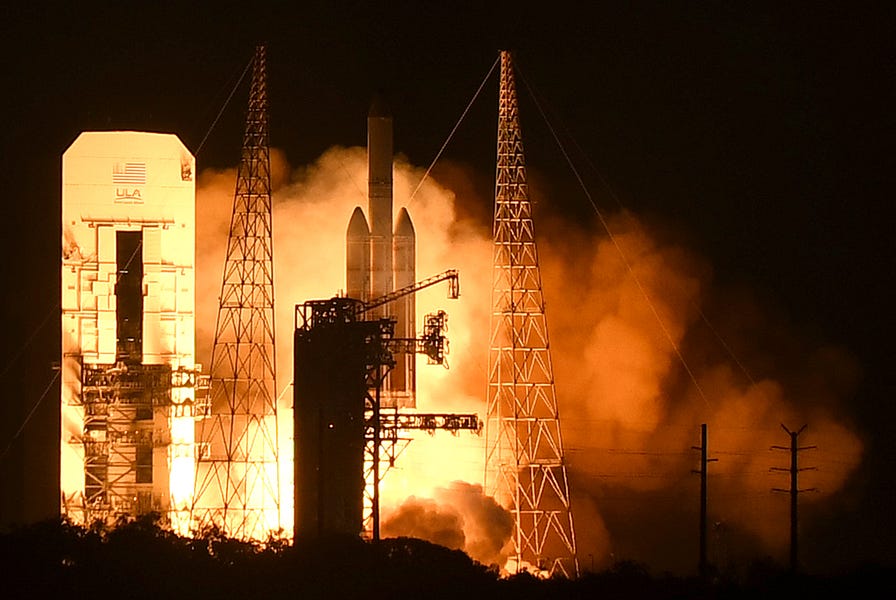Twenty years ago, a congressionally mandated commission warned of a “Space Pearl Harbor” if the United States did not act urgently to protect its assets orbiting above the Earth. Despite this warning, Washington failed to take sufficient steps. Too many Americans assumed the United States would enjoy unchallenged access to the ultimate high ground indefinitely.
Not surprisingly, America’s great power competitors are unwilling to accept American supremacy in space. Since the commission’s January 2001 report, Russia and China have worked overtime to develop the means to deprive the U.S. military of its comparative advantage in space, developing capabilities that could disable or destroy American satellites. Both governments understood that the U.S. military increasingly relies on space: Satellites provide navigation, communication, intelligence, surveillance, and reconnaissance capabilities vital to a variety of missions including missile defense.
Based on the efforts of Moscow and Beijing, the Department of Defense can no longer confidently assume that it would have reliable access to space assets in a great power conflict. In fact, just two months ago, Gen. Mark Milley, chairman of the Joint Chiefs of Staff, sounded the same alarm. “The next Pearl Harbor could happen in space,” he cautioned.
What is the goal of America’s adversaries? According to academics associated with the People’s Liberation Army, China could use anti-satellite (ASAT) capabilities to “blind and deafen the enemy,” depriving the U.S. military of key space-based capabilities. That would be a boon for authoritarian aggressors and a disaster for American national security and the warfighters who keep us safe.
This dangerous reality did not develop overnight.
As early as 2007, China showed it could shoot down satellites in low Earth orbit. In a widely publicized test, Beijing fired a ground-based interceptor at a weather satellite orbiting more than 500 miles above the Earth (apparently unconcerned about creating thousands of pieces of dangerous debris that would remain in orbit for decades). The missile successfully destroyed the satellite.
Russia has been developing a similar capability too. Moscow conducted its latest test last December of a ground-based interceptor, which the Department of Defense says is capable of destroying satellites in low Earth orbit.
Unfortunately, Beijing and Moscow are not stopping with ground-based anti-satellite missiles. As a January 2019 Defense Intelligence Agency report noted, both China and Russia are developing capabilities to disable American satellites via jamming, cyberspace, directed-energy weapons (Pentagon-speak for lasers), and so-called “on-orbit” technology.
Consider an example from November 2019. That month, Russia launched the Cosmos 2542 satellite on an otherwise unremarkable mission as an inspector satellite. But a couple weeks later, Cosmos 2542 mysteriously split into two satellites. From Cosmos 2542 a second satellite emerged—Cosmos 2543. Utilizing the classic Kremlin nothing to see here alibi, Russia’s defense ministry explained that its purpose was to assess the “technical condition of domestic satellites.”
Sounds reasonable, right?
But then Cosmos 2543 settled into an orbit next to a U.S. satellite and later released a high-speed projectile—an action the U.S. Space Command considered an anti-satellite weapons test.
That gives Washington plenty to worry about. Maneuverable Chinese or Russian killer satellites could sidle up to American satellites, conducting espionage and jamming transmissions, or launching directed energy or kinetic attacks.
These increasing threats to America’s early warning satellites are not hyperbolic horror stories swapped by paranoid Pentagon analysts at lunch. These capabilities actually have potential real-world implications.
In January 2020, Iran fired more than a dozen ballistic missiles at two bases in Iraq housing U.S. troops. The Department of Defense had no ballistic missile interceptors in range, leaving the American service members vulnerable. While more than 100 American troops tragically suffered traumatic brain injuries, no Americans died.
What explains the lack of deaths? Among other things, American satellites.
Early warning satellites alerted American forces to the incoming missiles and revealed where they were headed. Strategic communication satellites then enabled leaders to transmit the warning to the troops in harm’s way. As a result, when the missiles arrived, America’s service members had already taken cover.
Imagine if Tehran had the ability to first disable or destroy American satellites. Dozens or hundreds of Americans might have been killed.
Now, instead of a single attack on a couple of bases from Tehran, imagine China or Russia launching a simultaneous swarm attack on U.S. and allied forces in multiple locations preceded or accompanied by surreptitious or direct attacks on American early warning and communication satellites.
Beijing could employ such a tactic before an assault on Taiwan. Moscow might use the same tactic before launching aggression in the Baltics. This approach could catch American and allied forces flat-footed, potentially permitting China or Russia to accomplish coveted military objectives before American forces even started to move.
Worse yet, either great power competitor could use these anti-satellite capabilities to support an attack on the American homeland.
Thankfully, the United States has started to take concerted action.
The Trump administration created U.S. Space Command in August 2019 and established the U.S. Space Force in December 2019. The establishment of the Space Force gave rise to the first new military branch since the creation of the Air Force in 1947. It remains to be seen, however, whether these changes will add military capability and deterrence or simply redundant bureaucratic infrastructure.
Congress may need to provide the Space Force robust resources and equally robust accountability – holding the new service to its pledge to be streamlined, agile, and innovative.
The Space Force needs to make America’s military space infrastructure more resilient against the attacks China and Russia might mount, retaining vital capabilities even if multiple satellites are knocked out of service. New programs for next-generation early warning or strategic satellite communications must not copy the all-eggs-in-one-basket architectures of their predecessors out of bureaucratic inertia.
Taking a page from the pioneering playbooks of companies like Planet and SpaceX, the Space Force should field larger satellite constellations made up of dozens or even hundreds of relatively inexpensive and disposable satellites. That would help ensure the U.S. could sustain multiple losses of satellites while retaining vital military capabilities.
The U.S. should also look to team up more systematically with tech-savvy democratic allies to secure shared interests in space. In December of last year, the U.S. and Japan signed a historic agreement to place Space Force space domain awareness sensors onto Japanese GPS-augmenting satellites. The year prior, Norway agreed to host U.S. strategic communication payloads on Norwegian military satellites.
Such agreements can increase U.S. and allied capability and security in space while lowering costs for taxpayers.
America’s adversaries are sprinting to secure military supremacy in space. A focused American effort in the coming years, in close conjunction with key allies, can deter Chinese and Russian aggression in space and ensure Americans do not suffer a Space Pearl Harbor.
Bradley Bowman serves as senior director of the Center on Military and Political Power at the Foundation for Defense of Democracies. Major Jared Thompson is a U.S. Air Force Officer and a visiting military analyst at FDD.
The views expressed in this article are the authors’ alone and do not necessarily represent the views of the Department of Defense or the U.S. Air Force.







Please note that we at The Dispatch hold ourselves, our work, and our commenters to a higher standard than other places on the internet. We welcome comments that foster genuine debate or discussion—including comments critical of us or our work—but responses that include ad hominem attacks on fellow Dispatch members or are intended to stoke fear and anger may be moderated.
You are currently using a limited time guest pass and do not have access to commenting. Consider subscribing to join the conversation.
With your membership, you only have the ability to comment on The Morning Dispatch articles. Consider upgrading to join the conversation everywhere.